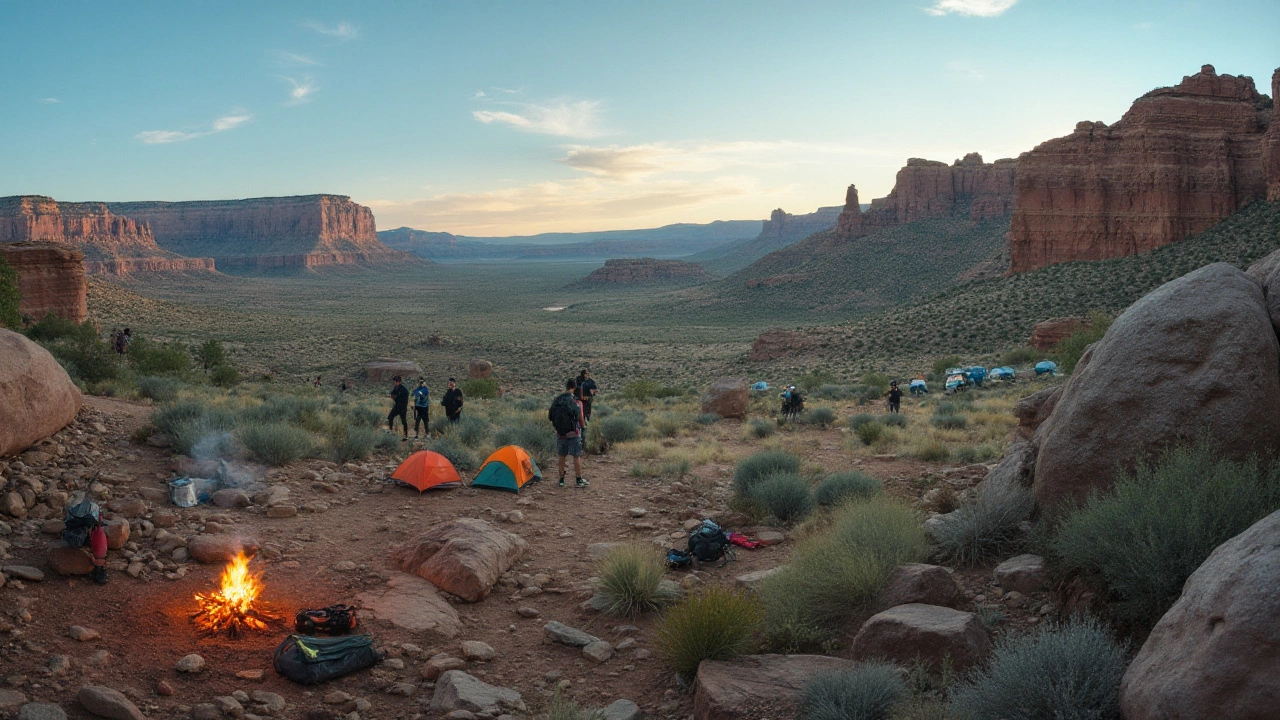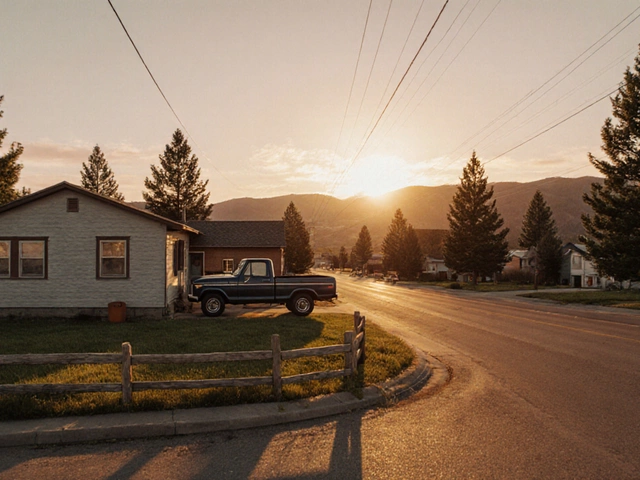Utah's land is a hot commodity these days. If you've been glancing at real estate listings, you might be wondering why prices seem to be on an upward trajectory. While picturesque mountains and stunning landscapes definitely add appeal, there's more at play in the climb of land prices here.
Much of what makes Utah enticing also drives its value upwards. From burgeoning business developments to a population growth that's among the fastest in the nation, the state is bustling with activity. This growth doesn't just mean more people and businesses, but it also leads to increased demand for land—be it for homes, commercial use, or the ever-popular recreational purposes that Utah is celebrated for.
Understanding the local economic dynamics, transportation advancements, and burgeoning areas can offer insightful perspectives. With these elements in mind, potential land buyers can navigate the nuances of Utah's real estate more confidently.
- Economic Growth and Development
- Population Increase and Urban Expansion
- Rising Demand for Recreational Land
- Impact of Infrastructure and Transportation
- Tips for Buying Land in Utah
Economic Growth and Development
Utah has been basking in an economic renaissance, transforming from a hidden gem of the West into a powerhouse of opportunity. The state's impressive GDP growth rate has consistently outpaced that of the national average, painting a picture of prosperity that few states can match. This economic surge isn't a result of luck or coincidence. It's a concoction of strategic initiatives, resourceful leadership, and an entrepreneurial spirit that's almost contagious. Businesses ranging from tech startups to well-established key players are setting up shop here, lured by a business-friendly environment, relatively low taxes, and a workforce that's as talented as it is diverse.
The tech scene in Utah, often referred to as the 'Silicon Slopes,' has particularly flourished, contributing a significant chunk to the economic upturn. The proximity to prestigious universities such as the University of Utah and Brigham Young University provides a constant inflow of fresh talent and innovative ideas. Companies like Adobe and Microsoft have set substantial operations in the state, contributing to the rising demand for commercial spaces and subsequently pushing land prices higher. A strong sense of community collaboration among these tech firms fosters an environment ripe for groundbreaking developments and opportunities, adding another layer of attractiveness to the land value.
"Utah’s economic momentum is a testament to the creativity and industriousness of its people," noted Jonathan Ball, a seasoned analyst.
The economic infusion isn't just limited to tech. Other sectors, including the film industry, have found a home in Utah, thanks to its diverse landscapes and favorable tax incentives. Films and TV shows, both big and small, look to Utah’s backdrop for their productions, which bolsters local economies. Coupled with tourism related to national parks and ski resorts, these sectors augment a robust median income level, further entwining with the clamor for land as new residents flood the state to share in its economic prosperity. Economic growth has inevitably transformed Utah into a magnet for aspiration, driving up land prices as people rush to stake their claim in this vibrant land.
As Utah continues to climb the ladders of economic vitality, the state faces an interesting dilemma. While the growth has been beneficial, it has also stressed existing infrastructure and resources. Nevertheless, the ongoing endeavors by local governments in improving infrastructure—such as extending road networks and investing in sustainable resources—are aimed at accommodating this ever-expanding populace. This supports a healthy cycle of economic growth that promises to keep the property market vigorous. Balancing these economic scales remains a challenge, yet provides dynamic opportunities for investments that many are eager to capitalize on.
Population Increase and Urban Expansion
Utah's population has been on a steady rise, and this surge is one of the dominant factors driving the cost of land prices within the state. Over the last decade, Utah has consistently been among the fastest-growing states in the US. This increase is attributed to both a high birth rate and a robust influx of new residents drawn by economic opportunities and the attractive quality of life. As a result, urban areas like Salt Lake City and its neighboring suburbs have experienced significant expansion, with development projects attempting to meet the demand for housing and commercial spaces.
The state’s capital and largest city, Salt Lake City, is an illustrative example of how urbanization is unfolding across Utah. Once considered a mid-sized city with modest growth, it has now transformed into a bustling metropolitan area. The tech industry—particularly within the so-called ‘Silicon Slopes’—has been a magnet not only for new businesses but for scores of new residents seeking employment. The proximity to both innovation hubs and scenic natural landscapes makes these areas particularly appealing compared to other regions.
According to 2023 census estimates, Utah's population is expected to surpass 3.4 million, demonstrating a significant jump from previous years. This swift rise prompts the need for larger housing developments and infrastructure improvements to accommodate new residents. Larry Anderson, a renowned urban planner, stated in a recent interview, "We're seeing a dynamic shift in how people choose where to live. In Utah, the blend of job prospects with natural surroundings is unlike anywhere else."
The growth hasn't been confined to Salt Lake City though; smaller cities such as Provo and Ogden are also experiencing rapid development. These areas represent affordable alternatives yet maintain easy access to metropolitan amenities. However, such growth inevitably impacts real estate, leading to heightened demand for available plots and thus, increased land prices.
The Push for Sustainability in Urban Expansion
The rapid pace of urbanization brings about concerns regarding sustainability and green living. As Utah expands, it faces the challenge of balancing growth with ecological preservation. Cities are increasingly adopting smart growth strategies and sustainable development practices, promoting mixed-use developments that integrate living, working, and recreational spaces in a single vicinity. These strategies are intended to maximize land use efficiency, ultimately influencing the cost and availability of land for sale."To preserve what makes Utah unique, urban expansion needs harmonious planning," notes Sarah Lindstrom, an environmental consultant for the state. She emphasizes the importance of designing cities that remain functional while preserving the environment, a sentiment that is becoming increasingly echoed in community forums and civic planning meetings.
For anyone considering land for sale in Utah, understanding the dynamics of population growth and urban expansion provides a broader context for the pricing trends and availability of land. This insight is valuable for making informed decisions and recognizing potential investment opportunities. Therefore, whether you're an investor or someone looking to call this beautiful state home, it is essential to recognize the unyielding influence of Utah's growing population on the real estate landscape.

Rising Demand for Recreational Land
In recent years, there's been a noticeable surge in the demand for recreational land in Utah. This state, known for its stunning natural beauty, offers a plethora of outdoor activities that cater to adventure seekers and nature lovers. Whether it's the allure of the mighty canyons, such as the renowned Zion, or the enchanting appeal of the Great Salt Lake, these landmarks have become magnets for those eager to own a slice of the great outdoors.
One key driver behind this trend is the increasing popularity of remote work, which has allowed individuals to prioritize lifestyle over proximity to traditional urban centers. People are now more willing to invest in properties that offer a serene escape from their daily grind, turning mere dreams of living amidst nature into a tangible reality. This lifestyle shift has made Utah's landscape a prized possession, drawing buyers both from within the United States and internationally.
"The state of Utah offers unique possibilities for those looking to blend recreation with residence, making it an attractive destination for real estate investment," asserts John Taylor, a prominent analyst in the field.
Another contributing factor is the rise in multi-use land investment. Many buyers see the potential for both enjoying and profiting from lands that can be used for hiking, camping, or fishing, and are jumping at the opportunity to own land that offers flexible use. This dual-purpose appeal is not just a selling point but a promise of both leisure and potential revenue generation.
Tourism statistics in Utah continue to highlight the favorability of recreational spots, showing a year-on-year increase in visitors. For example, a significant rise in park visitors has been documented, reinforcing the idea that recreational properties aren't just seasonal fascinations, but enduring investments. Given this steady flow, buying land in these locales is seen as an inclination towards securing a piece of something both economically and experientially enriching.
Historically low interest rates have also played a part, as they have made real estate investments more accessible. Now, individual and corporate buyers look to secure land that could serve as a prime location for vacation homes or rental properties aimed at tourists. Additionally, what makes this dynamic more enticing are the relatively friendly property laws in Utah, which often favor potential buyers looking into diverse land uses.
As more individuals recognize the value tied to Utah's vast landscapes, the competition for recreational plots intensifies. The increased desire to carve out personal sanctuaries from busy urban life remains a strong motivator for acquiring land. And though the prices may seem steep, the investment is perceived as worthwhile, not only for its potential financial returns but also for the unparalleled lifestyle it can provide.
Impact of Infrastructure and Transportation
When assessing the factors behind Utah's rising land prices, one cannot overlook the critical influence of infrastructure and transportation developments. Enhanced infrastructure is not only a marker of economic prosperity but also a catalyst for property value escalation. Over the years, Utah has seen significant upgrades to its transportation networks, including expansions to the interstate highways and improvements in public transit systems, like the TRAX light rail. These projects have made many previously remote areas more accessible, attracting both investors and new residents who are seeking convenience without the congestion typical of urban centers.
The state's strategic investments in roadways and transit corridors have spurred development in regions that were once considered on the periphery. For instance, the expansion of Interstate 15 has seamlessly connected key economic zones, reducing travel time and thus making outlying areas more appealing to homebuyers and businesses alike. This accessibility has caused a ripple effect, where land that was once affordable and underutilized now sees a surge in demand. As more people flock to these areas, the demand for land naturally inches upward, aligning with the statewide trend of escalating property values.
Transportation Developments Driving Demand
Utah's commitment to enhancing its transportation infrastructure underscores a broader vision of interconnectedness and economic vitality. The FrontRunner commuter train, extending across several counties, exemplifies this effort. It not only eases daily commutes but also encourages residential development in towns along its route. People are increasingly drawn to areas where commuting does not equate to spending hours in traffic, making land in proximity to these lines both viable and valuable for future growth. As quoted by a regional planning expert,
The integration of advanced transportation systems is a key driver in reshaping urban dynamics and enhancing property markets across the state.
Furthermore, planned expansions in the Salt Lake City International Airport project embody the state's forward-thinking approach. The enhancement of this hub not only attracts tourism but also positions Utah as a global business center, directly impacting the commercial real estate market. These infrastructural advancements complement the state's natural allure and thriving economy, reinforcing why Utah land prices remain a topic of substantial interest. Indeed, transportation developments are more than just upgrades; they are transformative forces, redefining the real estate landscape and making strategic locations outside of major cities highly desirable.

Tips for Buying Land in Utah
When considering investing in land within Utah, a keen understanding of the local market dynamics is essential. First and foremost, potential buyers should familiarize themselves with the economic landscape. The state's growth in sectors like technology and aerospace has bolstered the need for both commercial and residential properties. As new business parks emerge around Salt Lake City and tech hubs flourish in areas like Lehi, assessing how these developments affect Utah land prices can provide a strategic advantage.
Another key aspect is understanding the legal and regulatory environment. Utah's land can span diverse zones, ranging from agricultural to commercial use; each has its own set of restrictions and opportunities. Researching zoning laws and discussing with local authorities can prevent future headaches. Hiring a local real estate attorney might also be beneficial to navigate these complexities. As land transactions can involve intricate legal nuances, expert advice can offer peace of mind and ensure a smooth process.
Physical characteristics of the land are equally important to weigh in your decision-making. Dividing land in the valleys from those in elevated, rugged terrains can significantly vary cost and appeal. Land in the Wasatch Front, where proximity to urban centers matters, tends to carry a different price tag than plots in remote corners. For those purchasing recreational land, ensuring accessibility during all seasons can impact its utility and return on investment. The geographical features may also influence future development plans, such as if the land is prone to certain weather conditions.
Due Diligence and Expert Advice
Conducting due diligence on environmental concerns is equally as important. In a state renowned for its stunning natural beauty, any ecological restrictions or conservation efforts can directly impact land value and utilization. If your plot is near protected parks or water bodies, regulations might limit certain activities. Examining such elements in advance is crucial. Experienced realtors well-versed in Utah properties often recommend conducting a thorough environmental assessment before finalizing any purchase. In the words of a seasoned Salt Lake City broker, "Understanding the full use potential of your land before buying is not just wise, it should be considered mandatory."
Lastly, financing the land purchase requires careful planning. Compared to traditional real estate loans, financing land can involve different terms and interest rates. Working with banks familiar with the Utah region or lenders specializing in land transactions could streamline the process. Explore options and quotes from multiple financial institutions to ensure you are securing the most favorable terms. Remember, while the state's natural allure may be a primary draw, ensuring fiscal responsibility should guide your venture into this promising market.





